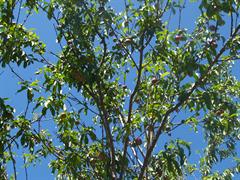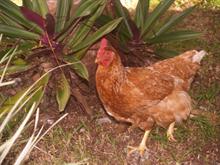Begin your Journey to Permaculture Expertise Here
Permaculture is a revolutionary, productive, ethical and environmentally sensitive approach to developing and managing the environment It is relevant to any size property from small urban houses to large rural farms.
Permaculture has a huge following globally both in developed and developing countries, and has been instrumental in bringing about dramatic changes in the lives and overall wellbeing of tens of thousands of people.
Expand your permaculture know-how
Completion of this course will help you to develop your ability to independently prepare plans for a permaculture system appropriate for particular environments and sites. Learn about the different growing methods which underpin permaculture, natural systems which constitute ecology i.e. the relationships between water, soils, plants and animals, zonal planning in permaculture systems and how plants, animals, fish and other components fit in. The course culminates in designing a permaculture system and preparing drawings.
This course is the best starting point you may find to launch intro either a new career, or more simply a new way of living.
- This course has been developed to satisfy the requirements of the Permaculture Design Certificate; is taught by graduates of that certificate (who also hold university qualifications in horticulture).
- Graduates can be awarded the PDC by the tutor, in addition to formal transcripts from this college.
COURSE AIM
Develop the student’s ability to independently prepare plans for a permaculture system appropriate for particular environments and sites.
DURATION: 100 Hours

COURSE STRUCTURE
The course is divided into eight lessons as follows:
- Permaculture Principles
- Natural Systems
- Zone & Sector Planning
- Permaculture Techniques
- Animals in Permaculture
- Plants in Permaculture
- Appropriate Technologies
- Preparing a Plan
Each lesson culminates in an assignment which is submitted, marked and returned with any relevant suggestions, comments, and if necessary, extra reading.
Course Duration 100 hours
Course Aims
- Explain the principles of permaculture
- Explain the concepts of natural systems.
- Explain permaculture techniques - involving zones and sector planning.
- Explain a range of permaculture techniques: (forest plantings, mandala gardens, etc).
- Explain the significance of different animals in a permaculture system.
- Select plants appropriate for inclusion in a permaculture system, to supply a useful and sustained harvest; explain their husbandry.
- Select appropriate technologies for use in permaculture systems.
- Draw permaculture designs (plans) to scale.

WHAT YOU MAY DO IN THIS COURSE
- Differentiate between Permaculture and other sustainable systems.
- Explain the procedures followed in practicing different techniques which are sympathetic to Permaculture, including:
- No-dig gardening, Companion Planting, Biological control, and Sustainable harvesting.
- Explain the interactions that occur between living and non-living components in five different natural environments, including: Forest Systems, Aquatic Environments, Soil Environments, and Arid Environments.
- Evaluate different Permaculture designs against the nine Permaculture principles.
- Distinguish between different garden zones in a Permaculture system.
- Explain sector planning in a specific garden design.
- Design a mandala garden for a specific site.
- Determine the appropriate use of swales on a sloping site.
- Investigate distinctly different Permaculture systems.
- Explain three different cultural techniques used to minimise the maintenance requirement, in Permaculture systems you study.
- Determine different animal breeds, which can provide a useful and sustained harvest from a permaculture system in your locality. Describe the harvest, treatment and use of various products derived from different types of animals in a Permaculture system.
- Explain the factors which can affect the success of different types of animals, in a Permaculture system, including: Poultry, Aquatic animals, Domestic farm animals, Insects, Earthworms.
- Describe the husbandry of one specified type of animal, in a Permaculture system visited by you.
- Determine different species of plants which can provide a useful, sustained harvest from a Permaculture system.
- Describe the harvest, treatment and use of various products derived from twenty different plant genera in a Permaculture system.

- Review lots of different plants which can be incorporated into Permaculture systems.
- Explain the factors which can affect the survival of different types of plants, including those used for: Vegetables, Fruits, Herbs, Fibres, Building materials, and Fuel.
- Explain the husbandry of one specified type of plant, in a Permaculture system visited by you.
- Explain the relevance of appropriate technology to Permaculture design.
- Compare three different waste disposal techniques which may be used for kitchen scraps in a Permaculture system.
- Compare three different waste disposal techniques which may be used for effluent in a Permaculture system.
- Evaluate the suitability of different building techniques in a Permaculture system.
- Explain the application of two different systems of alternative energy in a Permaculture system.
- Compare differences in the impact on a Permaculture system, of three alternative technologies designed for the same purpose (e.g. three alternative sources of electricity).
- Evaluate the use of technology in a house (your choose the house).
- Determine more "appropriate" technologies to replace currently used technologies, in a house you evaluate.
- Illustrate on a plan, twenty different components of a design, including: Plants, Buildings, and Landscape features.
- Transpose a simple Permaculture plan to a different scale.
- Represent an existing site, drawn to scale, on a plan.
- Describe the stages involved in the process of producing a Permaculture design.
- Prepare a concept plan for a Permaculture system surveyed by you, which is between five hundred and one thousand square metres in area.
- Prepare a detailed design for a Permaculture system of between five hundred and one thousand square metres in size, including: Scale drawings, Materials specifications, Lists of plant and animal types.
What is a Permaculture System?
A well designed permaculture garden will fulfil the following criteria:
- Upon maturity it forms a balanced, self sustaining ecosystem where the relationships between the different plants and animals do not compete strongly to the detriment on each other. The garden does not change a great deal from year to year, but it does none the less still continue to change.

- It replenishes itself. The plants and animals in the garden feed each other, with perhaps only minimal feed (eg: fertilizer) needing to be introduced from the outside.
- Minimal (if any) work is required to maintain the garden.
However, initially there may be high maintenance in order to get the garden going and established.
Weeds and pest problems are minimal due to companion planting and other "natural affects" which parts of the ecosystem have on each other.
- It is productive. Food or other useful produce can be harvested from the garden on an ongoing basis.
- It is intensive land use. A lot is achieved from a small area.
- There is a diverse variety of plant types used. This spreads cropping over the whole year so that there is no time when a "lot" is being taken out of the system. This also means that the nutrients extracted (which are different for each different type of plant or animal) are "evened out". Example: One plant takes more iron, while the plant next to it takes less iron...meaning iron doesn't get depleted because all of the plants have a high demand for iron. The diversity of species act as a buffer one to another.
- It can adapt to different slopes, soil types and other microclimates.
- It develops through an evolutionary process changing rapidly at first but then gradually over a long period perhaps never becoming totally stable. The biggest challenge for the designer is to foresee these ongoing long term changes.
Choosing a Site for a Permaculture Garden
A permaculture system can be developed on virtually any type of site, though the plants selected and used will be restricted by the site's suitability to the needs of the varieties used.
- For the culture of plants, it is generally regarded that facing the sun is most suited to productive plants because there is greater interception of light which produces greater fruit and yield. (i.e.. north facing slope in the southern hemisphere, south facing in the northern hemisphere).
- The siting of the productive plants should therefor be towards north.
- The siting of the house and other structures will depend on building design, construction restrictions, etc.
- A suitable aspect will need to be determined for animal shelters and the animals.
AFTER YOUR STUDIES
- You will have increased knowledge and understanding of what permaculture is.
- You will view outdoor landscapes (small and large) differently; seeing the potential to develop them into productive and sustainable ecosystems.
- Graduating from this course will give you a Permaculture Design Certificate (PDC); awarded by your tutor/mentor for this course, who themselves are graduates of a PDC.
- Passing our exam will give you a credit that can be used toward a certificate or diploma qualification with this school in either Australia or the UK
- Graduates have the opportunity to join the Permaculture Institute(UK) (ACS is a long term member).
- Graduates have an opportunity to obtain professional indemnity insurance at a special rate, under arrangements we have with major international insurance companies.
- Graduates are on request, provided with advice and assistance to move forward with a business or career in permaculture.